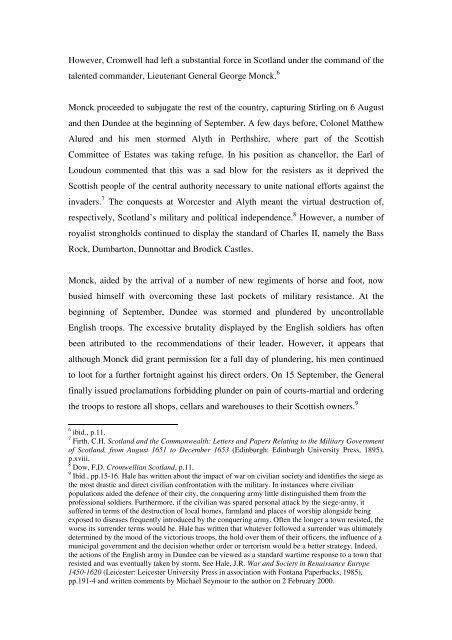The Glencairn Uprising, 1653-54 Helen Baker Department of ...
The Glencairn Uprising, 1653-54 Helen Baker Department of ...
The Glencairn Uprising, 1653-54 Helen Baker Department of ...
Create successful ePaper yourself
Turn your PDF publications into a flip-book with our unique Google optimized e-Paper software.
However, Cromwell had left a substantial force in Scotland under the command <strong>of</strong> the<br />
talented commander, Lieutenant General George Monck. 6<br />
Monck proceeded to subjugate the rest <strong>of</strong> the country, capturing Stirling on 6 August<br />
and then Dundee at the beginning <strong>of</strong> September. A few days before, Colonel Matthew<br />
Alured and his men stormed Alyth in Perthshire, where part <strong>of</strong> the Scottish<br />
Committee <strong>of</strong> Estates was taking refuge. In his position as chancellor, the Earl <strong>of</strong><br />
Loudoun commented that this was a sad blow for the resisters as it deprived the<br />
Scottish people <strong>of</strong> the central authority necessary to unite national efforts against the<br />
invaders. 7 <strong>The</strong> conquests at Worcester and Alyth meant the virtual destruction <strong>of</strong>,<br />
respectively, Scotland’s military and political independence. 8 However, a number <strong>of</strong><br />
royalist strongholds continued to display the standard <strong>of</strong> Charles II, namely the Bass<br />
Rock, Dumbarton, Dunnottar and Brodick Castles.<br />
Monck, aided by the arrival <strong>of</strong> a number <strong>of</strong> new regiments <strong>of</strong> horse and foot, now<br />
busied himself with overcoming these last pockets <strong>of</strong> military resistance. At the<br />
beginning <strong>of</strong> September, Dundee was stormed and plundered by uncontrollable<br />
English troops. <strong>The</strong> excessive brutality displayed by the English soldiers has <strong>of</strong>ten<br />
been attributed to the recommendations <strong>of</strong> their leader. However, it appears that<br />
although Monck did grant permission for a full day <strong>of</strong> plundering, his men continued<br />
to loot for a further fortnight against his direct orders. On 15 September, the General<br />
finally issued proclamations forbidding plunder on pain <strong>of</strong> courts-martial and ordering<br />
the troops to restore all shops, cellars and warehouses to their Scottish owners. 9<br />
6 ibid., p.11.<br />
7 Firth, C.H. Scotland and the Commonwealth: Letters and Papers Relating to the Military Government<br />
<strong>of</strong> Scotland, from August 1651 to December <strong>1653</strong> (Edinburgh: Edinburgh University Press, 1895),<br />
p.xviii.<br />
8 Dow, F.D. Cromwellian Scotland, p.11.<br />
9 Ibid., pp.15-16. Hale has written about the impact <strong>of</strong> war on civilian society and identifies the siege as<br />
the most drastic and direct civilian confrontation with the military. In instances where civilian<br />
populations aided the defence <strong>of</strong> their city, the conquering army little distinguished them from the<br />
pr<strong>of</strong>essional soldiers. Furthermore, if the civilian was spared personal attack by the siege-army, it<br />
suffered in terms <strong>of</strong> the destruction <strong>of</strong> local homes, farmland and places <strong>of</strong> worship alongside being<br />
exposed to diseases frequently introduced by the conquering army. Often the longer a town resisted, the<br />
worse its surrender terms would be. Hale has written that whatever followed a surrender was ultimately<br />
determined by the mood <strong>of</strong> the victorious troops, the hold over them <strong>of</strong> their <strong>of</strong>ficers, the influence <strong>of</strong> a<br />
municipal government and the decision whether order or terrorism would be a better strategy. Indeed,<br />
the actions <strong>of</strong> the English army in Dundee can be viewed as a standard wartime response to a town that<br />
resisted and was eventually taken by storm. See Hale, J.R. War and Society in Renaissance Europe<br />
1450-1620 (Leicester: Leicester University Press in association with Fontana Paperbacks, 1985),<br />
pp.191-4 and written comments by Michael Seymour to the author on 2 February 2000.
















